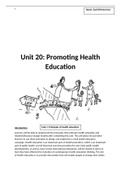1 Name: Zae12Mcmorrow
Unit 20: Promoting Health
Education
Introduction Task 1: Principles of health education
Learners will be able to understand the principles that underpin health education and
related behaviour change models after completing this unit. This will allow me and other
learners to use these principles to design and implement a small health education
campaign. Health education is an important part of health promotion, which is an important
part of public health. A brief historical overview precedes the unit. Early public health
developments, as well as more recent international milestones, will be viewed in terms of
how they have affected the evolution of contemporary health education thinking. The aim
of health education is to provide information that will enable people to change their habits
,2
for the betterment of their health and well-being. The importance of health educators will
be addressed.
Health education models based on victim blaming and empowerment will be explored. As
different approaches to health education, learners may consider the role of social
marketing, the mass media, community development, and two-way communication.
Throughout the unit, the use of new technologies in health education will be a major theme.
Learners will then explore various models of behaviour change, particularly in relation to
health education, and consider the impact of socioeconomic context on health education
outcomes. A major component of this unit is the design and implementation of a small-scale
health education campaign. Learners can identify appropriate aims and objectives related to
national and local health strategies and targets when designing the campaign. Learners
should have a solid understanding of the campaign's target audience and context. The
campaign's planning should include design principles as well as ethical considerations. After
that, I'll create a resource to help with a campaign. I'll then assess their individual resource
and its contribution to the campaign, as well as the overall campaign's success, at the end of
the campaign.
P1- Explain three different approaches to health education.
In this task, I will be explaining three different approaches to health education.
Health Education- Health promotion has developed from health education. Any mix of
learning opportunities intended to promote voluntary activities conducive to health is
referred to as health education. (sciencedirect, 2021) Students' awareness, skills, and
positive attitudes about health are all improved by health education. Physical, mental,
emotional, and social wellbeing are all topics included in health education. It encourages
students to take better care of themselves, prevent disease, and prevent risky behaviours.
(schoolchalao, 2021)
Health Promotion- Health promotion, which includes health education, is a combination of
educational and environmental supports for behaviours and living environments that are
conducive to good health. (sciencedirect, 2021) Individuals, families, neighbourhoods,
states, and the nation all benefit from health promotion. Everyone's quality of life is
improved by health promotion. Premature deaths are reduced when health is promoted.
(publichealth, 2021)
The History of Public Health
Many historical theories, trial and error, the advancement of fundamental sciences,
technology, and epidemiology have all contributed to the history of public health.
(sciencedirect, 2021) James Lind's clinical trial of various nutritional treatments of British
sailors with scurvy in 1756 and Edward Jenner's 1796 discovery that cowpox vaccination
prevents smallpox have modern-day implications, as nutrition and immunisation research
and practises are critical influences on health among the populations of developing and
industrialised countries. (sciencedirect, 2021) History can be used to gain a better
understanding of community health issues and how to address them. We imagine how
, 3
societies viewed and dealt with disease in the past through the eyes of historians. Disease
and death are facts that all communities must confront, and principles and strategies to
handle them must be developed. These methods are based on scientific experience and trial
and error, but they are often linked to cultural and social factors, as well as attitudes and
behaviours that play a role in deciding health status and curative and preventive treatments.
(sciencedirect, 2021)
Additionally, the history of public health is
a narrative about the search for successful
ways to protect people's health and
prevent disease. (sciencedirect, 2021)
Epidemic and endemic infectious disease
ignited pragmatic thinking and creativity
in disease prevention, often before
empirical causation was identified.
Defining pathogens, measuring their
prevalence, and finding successful
solutions are all part of the process of
disease prevention in populations. Trial and error, as well as expanding scientific medical
understanding, have shaped public health, which has been influenced by war and natural
disasters. (sciencedirect, 2021) As part of the growth of community life, especially
urbanisation and social changes, the need for organised health protection grew. Religious
and cultural values shaped how communicable disease was explained and regulated by
sanitation, urban planning, and medical care. Scientific investigation and the spread of
science have also been perceived as dangerous by religions and social structures, resulting
in the curtailing of public health progress, with recent examples including resistance to birth
control, immunisation, and food fortification. (sciencedirect, 2021)
Health Educators
World Health Organisation (WHO)
One of the topics discussed by diplomats when they met in 1945 to create the United
Nations was the establishment of a global health organisation. (who, 2021) The World
Health Organisation's Constitution went into effect on April 7, 1948, which is now known as
World Health Day. Under the United Nations framework, their primary responsibility is to
guide and organise international health. Health systems, health in life, noncommunicable
and communicable diseases, preparedness, monitoring, and response, and organisational
services are their primary areas of focus. (who, 2021)
WHO assists countries in coordinating the activities of
governments and partners, such as multilateral and
bilateral institutions, funds and foundations, civil society
organisations, and the private sector. They achieve health
goals by collaborating and promoting national health
policies and initiatives. (who, 2021) WHO is working to





